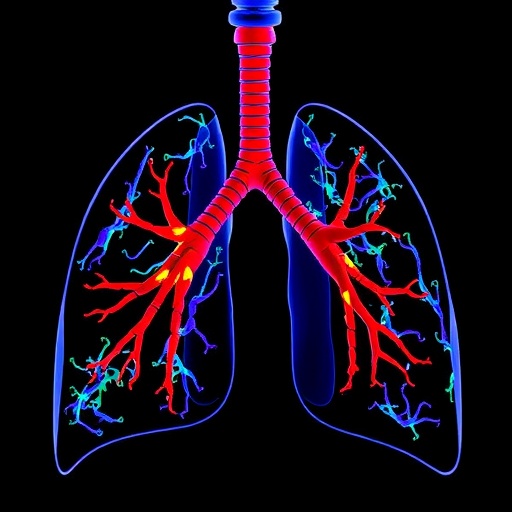In a groundbreaking development that could reshape the landscape of lung cancer diagnostics, researchers have introduced a novel monoclonal antibody clone named 3E2, designed for detecting programmed death-ligand 1 (PD-L1) expression with remarkable accuracy and cost efficiency. This advancement addresses a persistent challenge in oncology: the need for affordable yet reliable PD-L1 assays to guide immunotherapy decisions in lung adenocarcinoma (LUAD) patients.
PD-L1 expression has become a pivotal biomarker in identifying patients who are likely to benefit from immune checkpoint inhibitors targeting the PD-1/PD-L1 pathway. However, existing assays, such as the widely used SP263 pharmDx, pose significant financial hurdles for many healthcare systems and patients alike, limiting widespread access to precision medicine. Against this backdrop, the creation of the 3E2 antibody clone promises not only to curtail costs but also to maintain rigorous diagnostic standards.
The development of 3E2 utilized the hybridoma technique — a robust and time-tested methodology that fuses specific B cells with myeloma cells to produce monoclonal antibodies with defined specificity. From an immunogenic screening of thirty candidate PD-L1 antibodies, 3E2 emerged as the most sensitive and specific option. This clone was then systematically evaluated against established commercial clones including SP263, Cell Signaling Technology’s E1L3N, and Abcam’s 28–8, across a cohort of 101 patient-derived LUAD tissue samples.
Immunohistochemical analyses revealed that 3E2 demonstrated profound concordance with the Abcam 28–8 clone, exhibiting an impressive accuracy rate of 90.1% and a kappa coefficient (κ) of 0.797, indicating almost perfect agreement. This finding is particularly significant as 28–8 has been one of the gold standards in PD-L1 immunohistochemistry, meaning 3E2 can be considered a reliable alternative without sacrificing diagnostic precision.
By contrast, comparisons of 3E2 with CST E1L3N and SP263 showed moderate and limited agreements, respectively, as reflected by accuracy rates of 69.8% (κ = 0.401) and 55.4% (κ = 0.262). Intriguingly, these latter clones tended to detect higher levels of PD-L1 expression, raising questions about differential sensitivity thresholds and staining patterns that might influence clinical interpretations. Such discrepancies underscore the technical complexities involved in standardizing PD-L1 testing and the critical need for carefully validated assays.
Further statistical validation using Bland–Altman plots — a method renowned for assessing agreement between two quantitative measurements — confirmed minimal bias between the 3E2 and 28–8 clones. This quantitative approach bolstered confidence in 3E2’s reproducibility and consistency, fundamental attributes for any diagnostic tool intended for routine clinical practice.
Beyond detecting PD-L1 expression, the study ventured into exploring the prognostic value of the 3E2 antibody in patients receiving immunotherapy. Survival analysis revealed a statistically significant correlation: patients exhibiting PD-L1 expression levels of 5% or greater, as identified by the 3E2 clone, showed markedly better clinical outcomes. This link suggests that 3E2 not only serves as a diagnostic agent but may also hold predictive power, guiding therapeutic choices that enhance patient survival.
The potential clinical impact of introducing a cost-effective yet accurate PD-L1 assay like 3E2 cannot be overstated. It promises to democratize access to personalized immunotherapy by enabling more healthcare providers, even those in resource-constrained settings, to stratify patients appropriately. Consequently, the paradigm of lung adenocarcinoma management may shift, improving patient outcomes on a broader scale.
Nonetheless, while early results are encouraging, investigators emphasize the need for further validation through larger, multicenter clinical trials. Corroborating 3E2’s diagnostic performance and prognostic relevance in diverse populations and across different tumor types will be essential before it can be adopted as a clinical standard.
This study also highlights the intricate biology of PD-L1 expression and its manifestation across various tissue contexts, including placenta and normal gastric mucosa, which serve as positive and negative controls respectively. The fine-tuning of antibody specificity to these biological nuances ensures accuracy, preventing false positives or negatives that could misguide treatment.
The development of 3E2 epitomizes the innovative spirit driving translational cancer research, where scientific rigor meets practical application. By leveraging hybridoma technology combined with methodical comparative analyses, researchers have propelled the search for accessible diagnostic solutions forward.
In sum, the 3E2 monoclonal antibody offers a promising avenue for routine PD-L1 testing in lung adenocarcinoma. Its high concordance with established clones, combined with preliminary evidence of prognostic utility, sets the stage for a new chapter in personalized oncology. As the field advances, such tools will be indispensable in delivering precision medicine that is both clinically effective and financially sustainable.
The findings of this pivotal research will undoubtedly resonate within the oncology community, potentially inspiring further innovation in antibody development and immunodiagnostic techniques. As cost barriers fall, the oncology world moves closer to a future where every patient’s molecular profile can be accurately assessed and addressed.
The advent of 3E2 reaffirms the critical role of antibody engineering in enhancing cancer diagnostics, while simultaneously underscoring the challenges inherent to assay standardization across global healthcare contexts. The balance between sensitivity, specificity, and affordability remains at the heart of these endeavors.
Future research will likely delve deeper into the molecular binding characteristics of 3E2, its affinity, epitope specificity, and how these factors compare mechanistically with current PD-L1 antibodies. Such studies will deepen understanding and reinforce clinical confidence in employing this novel clone.
As immunotherapy gains ever-greater prominence in oncology, tools like 3E2 are poised to become indispensable, enabling oncologists to tailor treatments with unparalleled precision. The ripple effects of this development could accelerate the momentum toward universal, equitable cancer care.
This breakthrough not only serves the pressing needs of LUAD patients but may also have wider applications in other malignancies where PD-L1 expression guides immunotherapeutic strategies. Cross-applicability will be an exciting frontier to explore as the 3E2 antibody undergoes further testing and refinement.
In conclusion, the introduction of the 3E2 antibody clone represents a significant stride toward optimizing and economizing cancer diagnostics. Its clinical evaluation marks a promising step forward in harnessing immunohistochemistry for improved patient stratification and outcome prediction in lung adenocarcinoma, heralding hope for enhanced, accessible cancer care worldwide.
Subject of Research: Clinical evaluation of a novel PD-L1 monoclonal antibody (clone 3E2) for diagnostic accuracy and prognostic value in lung adenocarcinoma
Article Title: Clinical evaluation of a novel-developed clone 3E2 for the detection of PD-L1 expression status in lung adenocarcinoma
Article References:
Qu, F., Wang, J., Zhao, Q. et al. Clinical evaluation of a novel-developed clone 3E2 for the detection of PD-L1 expression status in lung adenocarcinoma. BMC Cancer 25, 1593 (2025). https://doi.org/10.1186/s12885-025-14941-z
Image Credits: Scienmag.com
DOI: https://doi.org/10.1186/s12885-025-14941-z
Tags: affordable PD-L1 assaysbiomarkers for immune checkpoint inhibitorscost-effective cancer diagnosticsdiagnostic standards for PD-L1 testinghybridoma technique in antibody developmentimmunotherapy for lung adenocarcinomalung cancer immunotherapy advancementsnew monoclonal antibody 3E2overcoming financial barriers in cancer treatmentPD-L1 detection in lung cancerprecision medicine in oncologyspecificity and sensitivity of PD-L1 antibodies





